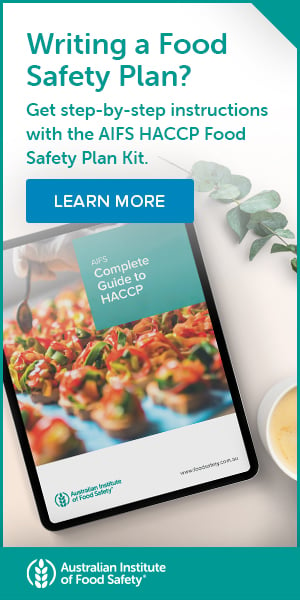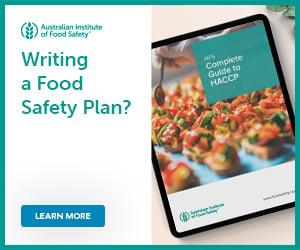
Navigating the complexities of food safety regulations is essential for every food business, and understanding the classification of your business under Food Safety Standard 3.2.2A can significantly impact your operations and compliance requirements.
Let’s delve into the differences between category one and category two businesses, as outlined under Australia's Food Safety Standard 3.2.2A, to help you understand what each entails and how these classifications could affect your business.
What is Food Safety Standard 3.2.2A?
Standard 3.2.2A is a mandatory update to the Australia New Zealand Food Standards Code, effective December 2022. It applies to Australian food businesses categorised as “one” or “two,” introducing stricter guidelines in three key areas: Food Handler training, food safety supervision, and record-keeping.
Training for Food Handlers is now more comprehensive, and businesses must designate at least one qualified Food Safety Supervisor. Record-keeping, especially for category one businesses, is also more stringent. Category one businesses face more rigorous regulations and must comply with all three food safety management tools, while category two businesses have slightly more relaxed rules.
The standard coexists with state or territory laws, making it crucial for businesses to understand and comply with both.
Category One Businesses: Key Characteristics
Food businesses that fall under category one under the updated standard have a few key traits:
- Category one businesses are involved in the direct handling of food that could be exposed to contamination before serving. This typically includes caterers and food service businesses.
- These businesses process unpackaged, potentially hazardous food. In other words, they convert raw materials into finished food products that could pose a safety risk if improperly handled.
- The food produced is ready-to-eat and potentially hazardous, requiring stringent safety measures to prevent contamination.
- The food is then served to consumers for immediate consumption, often in a dine-in setting and possibly via delivery or take-out.
Category one businesses include, but are not limited to:
- Restaurants
- Caterers
- Takeaway outlets
- Bakeries
Implications for Compliance
Due to the high-risk nature of their operations, category one businesses must maintain detailed records. These records facilitate both compliance verification and ongoing food safety assessment. Training and supervision requirements are rigorous, reflecting the elevated risks associated with these types of businesses.
What is a Food Safety Record?
In Australia's new Food Safety Standard 3.2.2A, "prescribed activities" refer to the handling and managing of unpackaged, potentially hazardous foods. These can include the preparation of meals ready for immediate consumption or the retail sale of ready-to-eat items.
Businesses mandated to keep records under this standard must document these prescribed activities. Such documentation is intended to validate a range of concerns, for instance, ensuring that hazardous food items are maintained at safe temperatures. Each record should be dated and, when relevant, time-stamped, along with a detailed description of the food or activity involved.
A record can be any form of documented information that provides evidence of adherence to the Food Safety Program. Records can include:
- Temperature logs for storage units
- Cleaning and sanitisation schedules
- Details about raw material suppliers
- Employee training documentation
- Customer complaints or incident reports
- Invoice notes
- Photos and video footage
Be aware that a record may cover multiple prescribed activities. For instance, the temperature log for a refrigeration unit could serve as a record for various types of potentially hazardous foods stored inside. Meticulous record-keeping – and keeping those records for at least three months – is not just a regulatory requirement but a crucial element in affirming a business's commitment to food safety.
Category Two Businesses: Key Characteristics
Let’s move on to the qualities of a category two business under Standard 3.2.2A:
Unlike category one businesses that process food, category two businesses handle unpackaged food but do not produce or process it.
These businesses still offer ready-to-eat, potentially hazardous food to consumers but don't engage in the full spectrum of food preparation.
Category two businesses either receive unpackaged food from suppliers or unpackage food themselves.
Food processing activities are limited to slicing, repacking, or hot-holding without minimal intervention.
Category two businesses include, but are not limited to:
- Convenience stores
- Service stations
- Delicatessens
- Market stalls
Implications for Compliance
While category two businesses also have strict guidelines to follow under Food Safety Standard 3.2.2A, their requirements are less stringent than those for category one businesses, reflecting the lower levels of associated risks. Record-keeping, although important, is optional for category two businesses.
Comparative Analysis
Here's a few of the differences:
- Category one businesses usually carry a higher level of risk due to the nature of their food handling and processing.
- Category one businesses must maintain detailed records for compliance and food safety verification, while category two businesses may have slightly less stringent record-keeping requirements.
- Category one businesses may be subject to more frequent and rigorous inspections due to their higher risk profile.
Know Your Category
Understanding whether your business falls under category one or category two as per Food Safety Standard 3.2.2A is crucial for ensuring you meet all compliance requirements. Failing to adhere to the guidelines can result not only in legal repercussions but can also severely damage your brand's reputation.
Knowledge of your category will enable you to implement the proper safety measures, train your staff adequately, and maintain the required records, thus ensuring consumer safety and business sustainability.
Regardless of your category, training is vital. The Australian Institute of Food Safety offers online, fully compliant Food Handler and Food Safety Supervisor courses to get your team up to speed.
Frequently Asked Questions
How do regulatory bodies ensure compliance and enforce Food Safety Standard 3.2.2A for both category one and category two businesses?
Regulatory bodies in Australia ensure compliance with Food Safety Standard 3.2.2A through a variety of enforcement mechanisms across different states and territories. The enforcement includes routine inspections, audits and the requirement for food businesses to keep detailed records of food safety practices.
- Inspections and Audits: Local governments and health departments conduct regular inspections to ensure that food businesses adhere to the standard. These inspections might be announced or unannounced, depending on the state or territory. During these inspections, businesses are required to present evidence of compliance, such as records of food safety training and the qualifications of their Food Safety Supervisors.
- Penalties and Sanctions: Non-compliance with the standard can lead to a range of penalties, including fines, temporary closures of the business, and, in severe cases, revoked licences. The severity of these penalties often depends on the nature of the violation and whether the business has previous instances of non-compliance.
- Public Disclosure: Some regions, such as New South Wales, maintain a 'name and shame' list that publicises the names and locations of businesses that fail to comply with food safety regulations. This not only acts as a deterrent but also informs the public about non-compliant establishments.
- Corrective Action Plans: In cases of non-compliance, businesses may be required to implement corrective action plans. These plans typically involve making necessary adjustments to food handling practices and retraining staff to ensure compliance is met in future inspections.
The comprehensive approach ensures that food safety standards are maintained across all food handling operations, protecting public health and ensuring businesses adhere to legal requirements. These enforcement measures are crucial for maintaining high standards of food safety and hygiene within the food industry.
Are there specific penalties or legal consequences for food businesses that fail to meet the requirements of Food Safety Standard 3.2.2A?
Yes, there are specific penalties and legal consequences for food businesses that fail to meet the requirements of Food Safety Standard 3.2.2A, which vary by state and territory in Australia:
- Financial Penalties and Fines: Non-compliance can result in moderate to substantial fines, depending on the severity of the violation. These fines are designed to serve as a deterrent and ensure that businesses take food safety regulations seriously.
- Temporary Closures or Permanent Shutdowns: In severe cases of non-compliance, businesses may face temporary suspensions or even permanent closure. This measure is typically reserved for repeat offenders or instances where a significant risk to public health is identified.
- Legal Actions and Lawsuits: Businesses may also face legal actions if their failure to comply with the standard results in food-borne illness outbreaks or other health hazards. Affected customers may sue for damages, leading to potentially devastating financial and reputational impacts on the business.
- Reputational Damage: Being listed on public registers such as the 'name and shame' lists, can lead to significant reputational damage. This public disclosure informs consumers about non-compliant businesses, potentially leading to a decrease in customer trust and revenue.
These penalties are enforced by local health departments and other regulatory bodies through inspections and audits, which help ensure that businesses adhere to the food safety practices mandated by the standard. Compliance not only avoids legal and financial repercussions but also enhances consumer trust and business reputation.
How frequently must food businesses update their food safety training and certifications under Food Safety Standard 3.2.2A to remain compliant?
Under Food Safety Standard 3.2.2A, food businesses must ensure that their food safety training and certifications are regularly updated to remain compliant. For example, Food Safety Supervisors must renew their certifications every five years. This requirement is to ensure that supervisors maintain up-to-date knowledge and skills in food safety practices, which are crucial for managing the safety risks associated with handling and preparing food.
While there isn't a specified frequency for the general food handler training updates mentioned explicitly in the texts, it is recommended that businesses ensure all food handlers have current and adequate food safety knowledge and skills relevant to their tasks. Regular refresher training is advised to keep pace with any changes in food safety standards, new health regulations or updates in business procedures.
This structured approach to training helps reduce the risk of food-borne illnesses and ensures that food businesses operate in compliance with both local and national food safety regulations.





